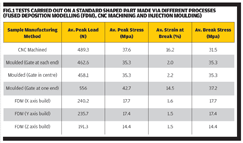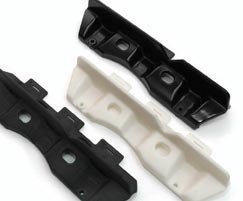Form and function are the core tenets of product design, but by not fully understanding the effects that manufacturing can have on materials, John Tumelty believes we’re working one sandwich short of a full picnic
Material science is a topic of immense depth and complexity and it doesn’t diminish that much even when you filter out a significant number metals, ceramics or plastics. With plastics alone, for instance, there are many thousands to choose from with a vast range of different chemical, mechanical, physical, aesthetic and processing properties.
Whilst I never set out to be a talented bore, my wife continuously reminds me of this innate ability, so I plan to keep this to a relatively simple overview of some key considerations that the designer should be aware of during a plastic product development phase.

figure 1
Form & function
The shift of focus within the design and engineering field in recent years has led to a disproportionate concentration on aesthetics when really what is required is a rounded approach, one which balances aesthetics with function, with performance, with manufacturing. The number of wild and eclectic chair designs that grace the covers of magazines and are never seen again is one of my pet hates – why bother?
Taking key decisions early
At a very early stage in the design process a lot of key decisions are often made in regards to the selection of materials. This is a result of many environmental or physical performance attributes being defined early on. e.g. must be able to operate in 120°C ambient temperature environment; must be able to support 200kg; mustn’t shatter when dropped etc. What is critical to remember is that this material selection process needs to be carried forward into the detail design phase.
wild and eclectic chair designs that grace the covers of magazines and are never seen again is one of my pet hates – why bother?
AdvertisementAdvertisement
Different plastics behave differently within the same geometry. Certain materials are more prone to sinking or creating voids, melt flow indices give a hint as to how well very thin sections will be filled (or not filled); fibre filled materials are prone to warping according to the alignment of fibre structure and the influence this has on shrink. If we then add in the variables associated with the design of a mould tool, then the list just grows and grows.
Variance is an issue
If we now look at various ways of achieving the same geometry in an ABS thermoplastic via different manufacturing methods, even more differences and difficulties become apparent.
Figure 1 shows standard tests carried out on a standard shaped part made via different processes (FDM, CNC machining and injection moulding) with three different gate locations for the moulded part to highlight the impact of gate positioning. What you’ll see is that even with the same material and same geometry processed in a variety of different ways, the manufacturing and processing methods can have a huge influence on the mechanical performance of the part.

In conclusion
To conclude, without waffling (too much), the material selection process is a minefield for the designer and a critical component of this selection process must be the final intended manufacturing process combined with how the geometry will influence this. The design process should not be segmented into isolated stages but should flow, continuously re-evaluating earlier conclusions before achieving completion.
John Tumelty is Managing Director of Proto Labs. His headquarters in Telford has more CNC technology than really should be allowed in one place.
{encode=”john.tumelty@protolabs.co.uk” title=”john.tumelty@protolabs.co.uk”}

John Tumelty looks at some key material considerations in product development






